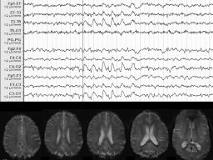PATHOLOGICAL AND PHYSIOLOGICAL FUNCTION IN THE INNER BAND OF [apos]DOUBLE CORTEX[apos]
Abstract number :
1.103
Submission category :
Year :
2005
Submission ID :
5154
Source :
www.aesnet.org
Presentation date :
12/3/2005 12:00:00 AM
Published date :
Dec 2, 2005, 06:00 AM
Authors :
1Regula S. Briellmann, 1Todd Little, 2Anthony B. Waites, 3A. Simon Harvey, 3Rani Jacobs, 1David F. Abbott, and 1Graeme D. Jackson
Double cortex is a neuronal migration disorder with a band of neurons located between the cortex and the ventricles. Previous studies have shown activation in these neurons during motor tasks. Using functional MRI, we assess the activation/deactivation pattern associated with higher cognitive functions and interictal discharges on EEG recording. We recruited two adolescent girls (age 13 and 14 years respectively) with double cortex. Both had frequent focal seizures and a highly active EEG, and delayed intellectual function (full-scale IQ 59 and 54 respectively). Functional MRI at 3T included a noun-verb task to assess language, and continuous fMRI/EEG to assess discharge-associated signal change. Data were analysed using SPM2, a laterality index was calculated for the language study to assess hemispheric lateralisation. Threshold for reporting fMRI results was at p=0.001. Structural imaging confirmed in both patients a thick subcortical band present in all lobes. Functional MRI of language showed left-hemispheric dominance for both patients, confirmed by the laterality index. The cortical activation pattern was typical for language studies (activation of the middle frontal, inferior frontal, angular and superior temporal gyri). Subcortical activation was found in areas of the band corresponding to cortical activation, additionally subcortical activation and deactivation was found in areas without overlying cortical signal change. FMRI/EEG was only successful in one girl. Fifteen occipital discharges were captured, they were associated with deactivation in occipital parts of the subcortical band (figure). No areas of activation were observed. Typical cortical language activation patterns can be present in adolescents with markedly impaired intellectual function. Neurons in the subcortical band are involved in physiological and pathological functions. These neurons may support or interfere with higher cognitive functions, and with the generation of epileptic discharges.[figure1] (Supported by Neurscience Victoria, the NHMRC Australia, and the Brain Imaging Research Foundation. We thank the patients and their families for the participation in the study.)
